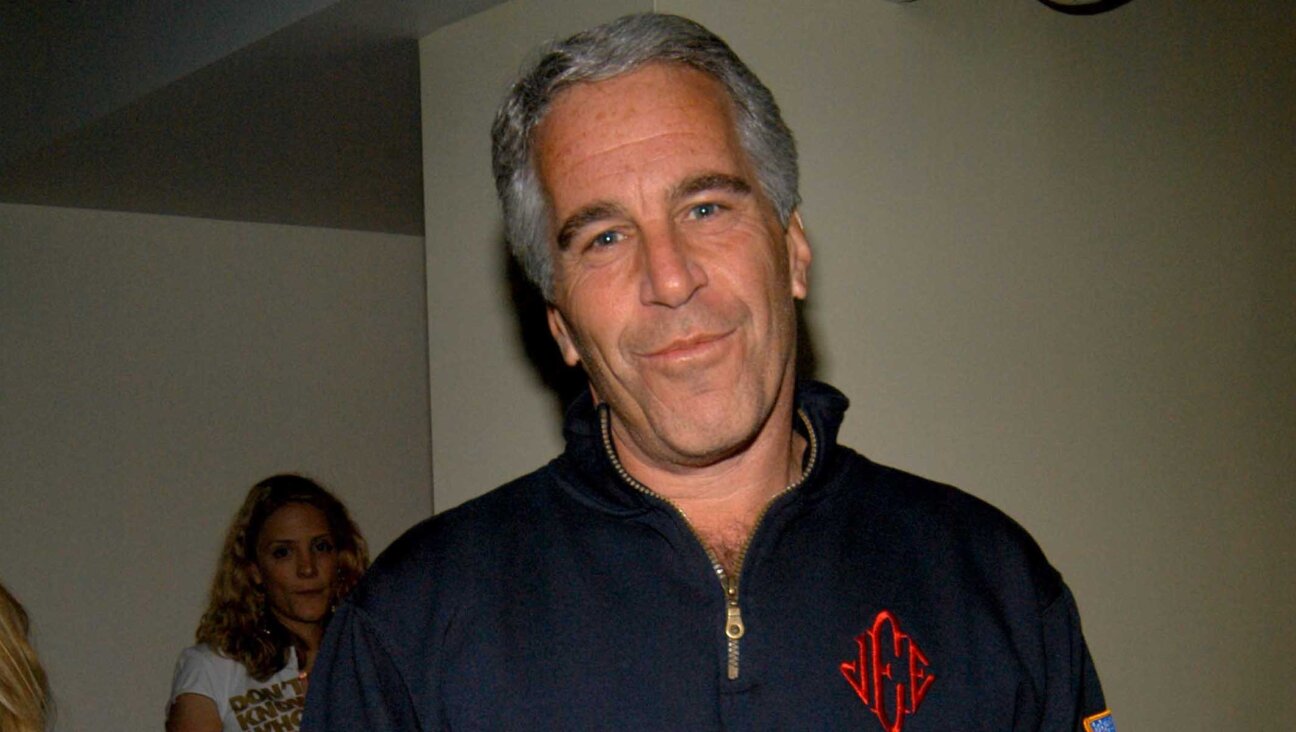Once a Critic, New Leader of Reform Judaism Promises Change

From New York to Africa: Rabbi Richard Jacobs of Westchester Reform Temple in Scarsdale, N.Y., selected to be the next head of the Reform movement, is also a board member of the American Jewish World Service. He visited children near the Chad border on an AJWS mission in 2005. Image by COURTESY OF RICHARD JACOBS
The rabbi chosen to head the largest Jewish religious organization in North America has not always toed the party line.
As the spiritual leader of a large, wealthy suburban congregation, Richard Jacobs is every part the modern Reform rabbi. A tall and well-spoken former dancer, he wears a green Save Darfur bracelet and a small blue yarmulke, and is active in social justice causes.
But he is also known for joining in biting criticism of the very organization he has now been nominated to lead.
After a months-long search, the Union for Reform Judaism announced on March 22 the selection of Jacobs as its new president, a post that will make him the de facto leader of Reform Judaism in North America. If Jacobs’s appointment is approved as expected by the URJ board in June, he will assume his new position when Rabbi Eric Yoffie steps down in July 2012.
Jacobs, 55, will inherit an organization facing steep fiscal challenges and increasing dissatisfaction from its stakeholders. Some of the most strident criticism has come in a recent statement by a small group of congregational rabbis — a group of which Jacobs is a founding member.
“I think what we were looking for, and what he is, is a Nehemiah, not a Jeremiah,” said Robert Heller, chairman of the selection committee, contrasting the biblical prophet known for rebuilding Jerusalem with the prophet known for grim visions of doom and destruction. “He’s saying, ‘Let’s rise up and build.’”
The URJ is an umbrella group of more than 900 Reform congregations that represents 1.5 million Jews and has a budget of about $27 million, not including its summer camps and Israel programs. Though the Reform movement overtook Conservative Judaism by 2000 as the largest Jewish denomination in North America, that growth appears to have stagnated.
Jacobs’s synagogue has 1,200 member households and is among the largest in the Reform movement. He has led that congregation for the past 20 years. Previously, he served as the rabbi of Brooklyn Heights Synagogue. He also serves on the boards of American Jewish World Service, UJA-Federation of New York and the New Israel Fund.
“Rabbi Eric Yoffie is a giant,” Jacobs said shortly before the announcement of his new position. But, he said, “we need a new path because the world is a different world…. We need some serious work to figure out where the next iteration of Jewish life is in the United States and Canada.”
Jacobs is among the 18 senior rabbis of large Reform congregations who came together to form the Rabbinic Vision Initiative in 2009. The group has been meeting with the official leadership of the movement’s branches for months, though only in March had it made its existence public.
Some in the Reform movement have criticized the RVI as elitist. In February, when the Forward publicly revealed the existence of the group, some rabbis condemned it for being exclusionary and leaving out leaders of smaller congregations.
In March, the RVI distributed a position paper among Reform rabbis that included a stinging condemnation of URJ operations. In an e-mail, the original convener of the RVI group, Rabbi Peter Rubinstein of Manhattan’s Central Synagogue, said that more than 200 Reform rabbis have agreed to co-sign the position paper.
The paper called the governance structure of the URJ “large and unwieldy, precluding effective and dynamic response to the changing realities of the Jewish world today.” It charged that the organization has underperformed in fundraising and development over the past 10 years; that the members of the RVI “sense a widespread concern in our movement that the URJ is not productively engaged in the real-life needs and challenges of its member congregations”; that the organization lacks a “culture of excellence,” and that it has generally “been left behind” as new, dynamic Jewish organizations move to the fore.
In remarks before a meeting of the URJ’s executive committee in mid-March that have been posted on the URJ’s website, Yoffie concurred with the RVI’s criticism while complaining that the group failed to note the successes of the organization he still heads.
“I am in substantial agreement with their critique of the movement, including the union,” Yoffie told the committee. He concluded, “To the RVI, let us say, ‘Thank you.’”
The heft of the RVI comes from the size of the congregations whose senior rabbis were its founding members. URJ dues are based on synagogue size, and the dues of the RVI rabbis’ synagogues are among the largest. Though the RVI has made no public statement indicating that its members are considering disaffiliating from the URJ, a URJ official confirmed that Wilshire Boulevard Temple, a 149-year-old Reform congregation led by Rabbi Steven Leder, an RVI founding member, has signaled its intention to leave the URJ this June. As of 2007, the synagogue was paying $245,000 in annual dues to the URJ.
Leder did not respond to a request for comment.
Members of the nominating committee said that Jacobs’s membership in the RVI had no impact on their decision to select him. “We were looking for a change agent,” Heller said.
When asked about the group, Jacobs responded, “I am not defined by the RVI.” But, he said, “I think my RVI colleagues are with me.”
Members of the URJ’s nominating committee point to Jacobs’s career as a congregational rabbi and to his experience revitalizing his own congregation as key reasons for his selection.
“The URJ is a congregational movement,” said Rabbi Ellen Weinberg Dreyfus of B’nai Yehuda Beth Sholom, in Homewood, Ill., outgoing president of the Central Conference of American Rabbis and a member of the nominating committee. “I think it will be very helpful to the people in the congregations to know that the new president has had experience on the ground.”
The fact that Jacobs had no previous role within the URJ administrative hierarchy is significant, since the URJ was roundly criticized over the 2009 reorganization that resulted in budget cuts and layoffs. The other finalist under consideration by the nominating committee was Rabbi Jonah Pesner, a URJ staff member who serves as director of Just Congregations, the URJ’s congregation-based community-organizing initiative.
In an e-mail to colleagues following the announcement, Pesner expressed support and admiration for Jacobs. “I have admired Rick since I was a rabbinic student,” Pesner wrote of Jacobs.
Jacobs said that he believes he was selected to lead the movement because of his success at Westchester Reform Temple and his involvement in the field of synagogue transformation. He was a board member of Synagogue 2000 and its successor group, Synagogue 3000.
“Congregations are what I know,” Jacobs said. “I understand when rabbis say it’s hard during economic [downturns] to figure out how you’re going to keep all the sacred functions going. That’s not a world I have to read about or call somebody about — that’s what I do every day.”
“He has the experience transforming an institution, but achieving the buy-in and support of those who have been there for a long time and those who are new,” Dreyfus said.
Jacobs has also been identified with social action causes. He delivered the opening prayer at the 2006 Save Darfur rally in Washington and spoke on CNN from a 2010 rally in support of the proposed Islamic center near ground zero. He has been a board member of NIF, which has been a target of right-wing critics in Israel in recent months.
“I’m very proud of almost 20 years of work with NIF,” Jacobs said when asked about the organization’s characterization as a left-wing group. Jacobs chaired the organization’s pluralism committee. “The work I’ve been doing is planting seeds of real tolerance,” he said. “I wouldn’t characterize it as left or right — I would characterize it as really important.”
Supporters of Jacobs speak of him as a leader and a visionary.
“I got to places that are themselves very moving, but to be there with Rick is to be moved at a different level,” said AJWS’s president, Ruth Messinger, who has traveled to Chad and Haiti with Jacobs. “He looks at it from a spiritual perspective… I end up having vast respect for somebody that can approach challenges with that level of serious, analytic, thoughtful, passionate work.”
Meanwhile, those inside the movement hope he will bring a sort of rebirth.
“Rick’s going to be a healer for this system. That’s his nature,” said Rabbi Daniel Freelander, senior vice president of the URJ. “He’s a leader and a healer, not an alienator.”
Contact Josh Nathan-Kazis at [email protected]






















